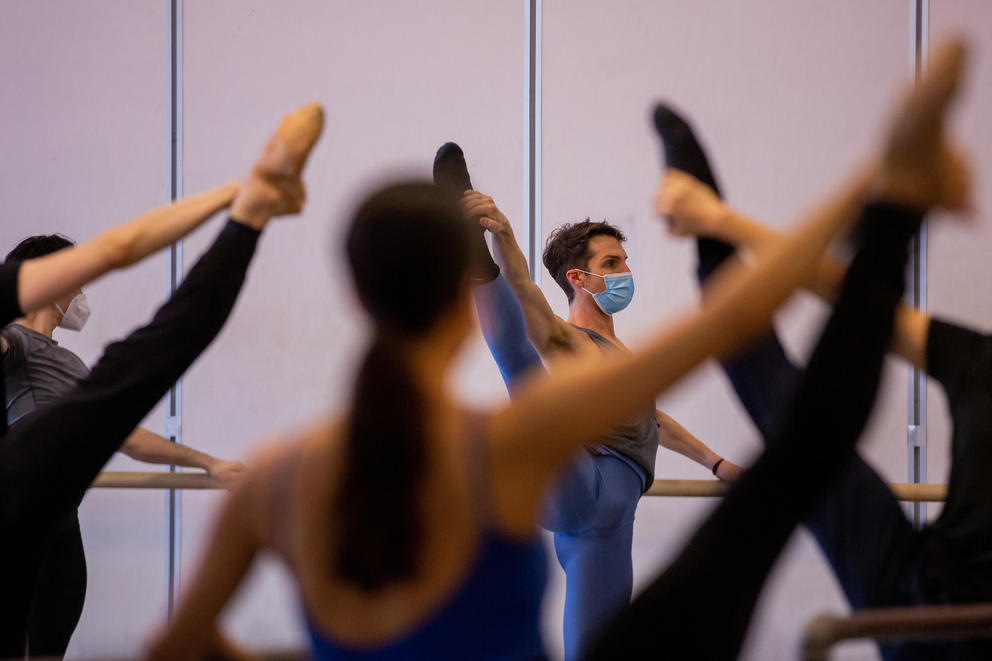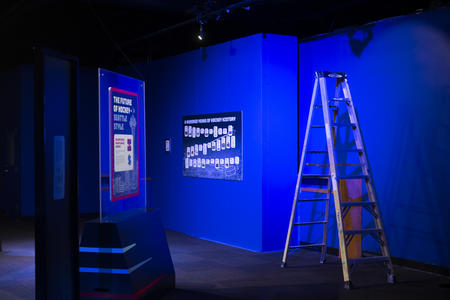“I forgot what it was like to do a live performance,” recalls Lesley Rausch, a principal dancer starting her 20th season with PNB. “During the course of the weekend I alternated between crying bouts and smiling so much my cheeks hurt. It was just an incredible experience.”
A year ago, Rausch feared she wouldn’t have that experience again.
Like virtually every performing arts organization in the region, PNB shut down abruptly in March 2020, heeding Washington state’s public gathering ban in response to COVID-19. Ballet dancers like Rausch, along with thousands of artists, craftspeople and support staff, were sent home — and nobody knew when they would come back to work.
The forced break was particularly poignant for an older dancer like Rausch.
Unlike artists in other forms, who decide for themselves when to stop working, ballet dancers have a limited number of years before their aging bodies and chronic injuries force them into retirement. In that way, they’re a lot like professional athletes, who can’t usually play past age 40. Rausch will hit that milestone this month, and maintaining the necessary physical conditioning to leap and spin across a stage — seemingly without effort — has become increasingly demanding.
“I wake up pretty early every day,” she says, “and take a very, very, very hot shower.”
Once she’s fully awake, Rausch spends a couple of hours running through the Pilates exercises she needs to prepare her body for the rigors of the daily PNB company class. She works on everything from strengthening the little muscles in her feet that allow her to dance on her toes to gaining the stamina to make it through a 10-minute duet.
Transitioning from pandemic isolation to the rigors of a ballet studio demands more than physical preparation, according to another senior PNB dancer, Noelani Pantastico. During the long months of the stay-at-home order, she struggled to summon the will to attend the remote Zoom classes PNB offered dancers last year. Like so many of us who suddenly had to work from home, Pantastico yearned for in-person “office” camaraderie.
More than loneliness, though, she felt emotionally pummeled by the daily news, particularly after George Floyd’s killing by Minneapolis police in May 2020. Watching the social justice uprising on TV left her wondering what value her traditional art form had in a rapidly evolving world. When she turned 41 this spring, Pantastico seriously contemplated retirement.
But she didn’t want her 25-year performing career to simply fade away. Pantastico didn’t know if her body was up to it, but, like Rausch, she yearned to dance on the McCaw Hall stage again, and she was willing to put in the work to make that happen.
“I want to make the most of the time I have left,” she says. “Some days that’s harder than others.”
Pantastico is particularly challenged by PNB’s contemporary repertoire, which requires classical ballerinas like her to perform more horizontal movements, instead of the vertical lines she’s used to. It has put pressure on her knees, which is why every lunch hour you’ll find her getting treatment from PNB’s in-house physical therapy team. She knows they can’t turn back the clock for her, but Pantastico says the pandemic break has instilled in her what she calls a new “consciousness,” an awareness of what her body is doing when she’s onstage.
“Maybe all my turns and jumps aren’t what they used to be,” she muses. “I was really down on myself for a while, but then I thought, ‘I’m 41 now. It just is what it is.’ ”
Pantastico is cautiously optimistic that she’ll be back to optimum form by February, when she’s scheduled to perform the title role in Romeo et Juliette. But she says her physical condition is always a question at the back of her mind.
“Can I do it? Can I get there?” she asks herself. “That’s what I’m battling.”
Unlike Pantastico and Rausch, many of PNB’s longtime company members did make the decision to leave during the pandemic closure, including both Pantastico and Rausch’s regular stage partners, Seth Orza and Jerome Tisserand.
Orza left this past August and has started a dance shoe company. His wife, Sarah Ricard Orza, also a PNB principal dancer, left in 2020 to become a doula. Tisserand and his wife Laura, another PNB principal dancer pair, left the U.S. to spend the end of their careers with Les Ballets de Monte Carlo. All of these departed dancers are in their late 30s; younger dancers have come in to replace them.
When Pantastico watches these new colleagues — many of them half her age — she sometimes wonders what, besides ballet, they have in common.
Fellow veteran Lucien Postlewaite feels the same way. As another longtime principal dancer at PNB, his priority is maintaining the conditioning and artistry that have brought him to the pinnacle of his profession. He tried to maintain a fitness regimen during the shutdown, but coming back to the studio full-time was a shock to his system.
“I think a lot of our muscles had time to atrophy over the break,” he says. “But I feel good getting a therapy team together: a doctor, an acupuncturist, a PT. We’re working to make sure everything stays in the right place.”
At age 37, Postlewaite acknowledges that he’s closer to the end of his career than to its start. With that timeline in mind, losing a year of performance felt like a gut punch. And finding emotional balance has been tougher than regaining his physical fitness.
“So much of what we do is psychological,” he says. “I’m glad Olympic athletes started speaking out about mental health.” He pauses, his eyes tearing up. “To be onstage, it’s not a state of [mere] survival. You have to be thriving.”
Postlewaite understands that his role at PNB has changed since the dancers came back to work full time in mid-August. The company’s younger dancers view him as more than a colleague.
“People see me as a role model, or someone to watch,” he says. “So when I see a younger dancer doing something and I can give them a tip, I do it.”
PNB Artistic Director Peter Boal has seen Postlewaite and the other company veterans take on mentorship roles. “One cannot overstate the importance of example in a ballet company,” Boal explained in an email. “I’ve witnessed dancers stepping forward in the most selfless way to help others with sage advice. Watching them pass the torch is to see the best of ballet and humanity.”
But when, like Postlewaite, you’re at the height of your career, you’re not necessarily enthused about passing a torch you still want to hold on to. The pandemic shutdown reinforced both his passion for ballet and his sense that being a dancer is central to his identity.
“It messes with your head, being away from your purpose,” he says. “I’m rebuilding that even now. I’m trusting and listening to my body in a way that is actually making my dancing improve.”
At 40, James Yoichi Moore’s biggest concern is not losing ground. Eighteen months away from the studio gave him time to recover from some nagging chronic injuries.
“I’ve got an ankle thing. And my back,” he says. “They’re repetitive stress injuries, which take time and rest to heal. And we don’t always have that luxury.”
Now that he’s back at work, so are the aching reminders of the years he’s devoted to ballet. “If I was 25, I’d have no worries,” he says. “You can recover so quick. When you have a company that’s 80% in their 20s, you know they’re going to feel fine on Monday. I’m not.”
He’s focused particularly on regaining his ability to jump; he spent much of the pandemic in a small apartment with low ceilings that didn’t allow for much vertical movement. And while Moore is practicing at PNB’s Phelps Center every day, he sometimes opts to take a company class virtually, in a separate room from his fellow dancers. He’s trying to stay as healthy as he can, for himself, as well as for his wife and their 2-year-old son, who’s too young to receive a COVID-19 vaccination.
Health and safety are very much front and center at PNB. All the dancers are vaccinated, and everyone is masked, even during strenuous rehearsals. When the dancers exit the rehearsal studios, they whip off their masks to take in deep gulps of fresh air.
And as for the audience, PNB — along with the Seattle Opera, Seattle Symphony and other local arts organizations that have welcomed back live audiences this fall — requires proof of vaccination or a negative COVID test to enter the theater, and masks must be worn except when eating or drinking. Seating is distanced.
On the season’s opening night, only about 1,100 people were in the 3,000-seat McCaw Hall. But when Boal went out to talk to the audience before the performance, the dancers backstage could hear the small crowd roar.
“We just felt this love we’d been missing,” Postlewaite recalls. He vows to return that affection by giving everything he’s got to every ballet he performs.
The company has been rehearsing the three dances slated for PNB’s second live program, Beyond Ballet (Nov. 5-7). It’s also getting ready for the annual production of George Balanchine’s The Nutcracker, opening Nov. 26 for a holiday run (through Dec. 28).
Lesley Rausch is busier than she has been since before the pandemic. She’s exhausted, but also extremely grateful. “Gratitude to my body, that it’s able to keep doing what I’m asking it for,” she says. “And on top of that, just gratitude for the chance to get to dance again. Live.”
Get the latest in local arts and culture
This weekly newsletter brings arts news and cultural events straight to your inbox.










